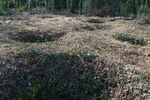Social:Prehistoric storage pits
Storage pits were underground cists used by many people in the past to protect the seeds for the following year's crops and surplus food from being eaten by insects and rodents. The underground pits were sometimes lined and covered, for example with slabs of stone and bark and tightly sealed with adobe.[1]
Examples
Sannai-Maruyama site in Aomori, Aomori Prefecture, Japan, contains storage pits that were used when hunter-gatherers transitioned from a nomadic lifestyle to settled villages about 3900 BC to 2900 BC. Large storage pits were built underground to conceal their presence, a preferred method used by mobile populations in many parts of the world.[2][3][4]
Worlebury Camp storage pits are 93 storage pits found at the Iron Age hill fort that stood north of the town of Weston-super-Mare in Somerset, England. The pits were cut into bedrock for "keeps", one is a ditch for protection[5]), and 74 are outside the "keep" but still enclosed within the exterior walls.[6] The inhabitants used them to store grain, as is evidenced by the kernels of barley and wheat and the shards of pots that were found in the pits. Also found were remains of burned woven baskets and, dated to the 2nd or 1st century BC, sling stones and spindle whorls.[6][7] and close to the village of Worle.[8] Remains of human skeletons were found in 18 of the pits,[9] 10 of which show evidence of a violent death.[10][11]
References
- ↑ Man in the San Juan Valley. Aztec Ruins National Monument, National Park Service. January 13, 2001. Retrieved 10-18-2011.
- ↑ Shibuya, Tomoko. "Sannai-Maruyama excavation illuminating Jomon life" The Japan Times 6 Oct. 1997. Retrieved 12 Nov. 2008.
- ↑ Habu, Junko. "Growth and decline in complex hunter-gatherer societies: a case study from the Jomon period" Sannai Maruyama site, Japan.
- ↑ Sannai-Maruyama. "The Sannai Maruyama Site." Sannai Maruyama. Sannai-Maruyama Site Preservation Office. Web. 7 Dec. 2011.
- ↑ "Fosse". Princeton University. http://wordnetweb.princeton.edu/perl/webwn?s=fosse. Retrieved 19 December 2010.
- ↑ 6.0 6.1 Dymond, Charles William (1886). Worlebury, an Ancient Stronghold in the County of Somerset. John Wright and Co. Printer, Stone Bridge. https://books.google.com/books?pg=PA31&lpg=PA11&dq=roman+coins+at+worlebury+camp&id=NUDnAAAAMAAJ&ots=vFGHU3DWt5#v=onepage&q=roman%20coins%20at%20worlebury%20camp&f=false.
- ↑ "Fortified England - Worlebury Camp". Fortified England. http://www.fortifiedengland.com/Home/Categories/ViewItem/tabid/61/Default.aspx?IID=1551. Retrieved 7 December 2010.
- ↑ "Welcome to the web site of the Worlebury Residents' Association". Worlebury Residents' Association. http://www.worlebury.co.uk/wra.html. Retrieved 6 November 2010.
- ↑ "Worlebury Camp". Megalithic Portal. http://www.megalithic.co.uk/article.php?sid=4976. Retrieved 24 January 2010.
- ↑ Gerry Brooke (December 1, 2009). "Footsteps into History - Worlebury". Bristol Evening Post. This is Bristol. Archived from the original on 5 May 2013. https://archive.is/20130505063630/http://www.thisisbristol.co.uk/news/Undefined-Headline/article-1560745-detail/article.html. Retrieved 29 October 2010.
- ↑ "Weston super Mare - A Brief History". Weston-super-Mare. http://www.weston-super-mare.com/newhistory/newhistory.html. Retrieved 19 December 2010.
 |



